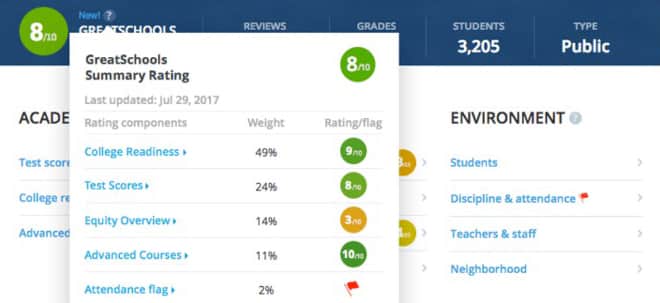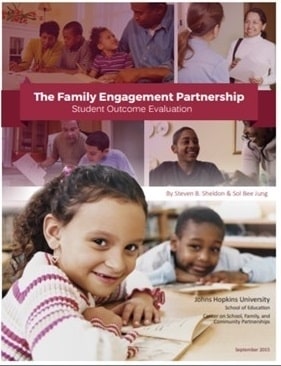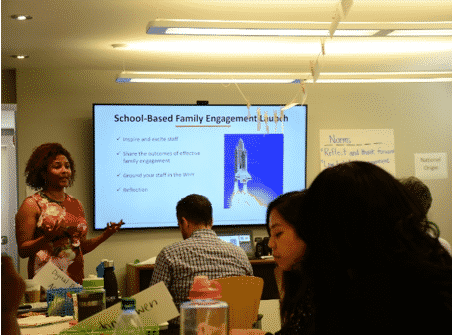LINKING TO STUDENT OUTCOMES
 All education efforts are rooted in the commitment to help students succeed in their education so that they can fully realize their potential and own their path in life.
All education efforts are rooted in the commitment to help students succeed in their education so that they can fully realize their potential and own their path in life.
As such, any parent empowerment campaign should be deliberate about identifying what student outcomes it intends to impact and how it will measure its success.
We are agnostic about which student outcomes a parent empowerment effort should make its focus. Measures of student outcomes can include:
- Attendance, staying in school and behavior/discipline. All of these are important pre-cursors to learning and indicators of a healthy learning environment. Additional outcomes include measures of student, parent and teacher perception about school culture.
- Educational achievement (formative and summative assessments).
- Educational attainment such as grade advancement, high school graduation, college going and college completion.
- Educational measures that fall under the categories of socio-emotional skills, character, life skills, executive/workplace/career skills, meta-cognitive skills, non-cognitive skills, identity development, physical health, mental health, etc – even as how to measure many of these categories remains a work in progress for our field.
We are not attempting to resolve the debate about which of the above measures matter most. We simply believe that parent empowerment campaigns can and should be explicit about which ones they seek to impact.
This approach is vital not only for internal planning and priority-setting (“are we focused on the right agenda with the right programming based on what student outcomes we want to benefit?”) but also to create a social contract with parents, policymakers, funders and other stakeholders.
An organization’s campaign should also differentiate between student outcomes it holds itself accountable for (and wants to be held accountable to by others) from student outcomes it will track but not measure its success against. For example, a campaign focused on elementary or middle school will likely focus on measuring and holding itself accountable for outcomes like attendance, behavior and/or proficiency on grade-specific tests rather than longer-term outcomes like high school completion and post-secondary success. This organization may care deeply about those long-term outcomes, but it may not be able to directly measure how its efforts – even if successful – contribute to them.
There are five methods parent empowerment efforts can employ to measure student outcomes
There are (at least) five methods organizations leading parent empowerment work can use to link their work to student outcomes:
#1. Data on student outcomes for specific student populations: Some organizations invest in collecting data on changes in various student outcomes (see list above) for specific groups of students. The amount of effort this requires depends on the existing information systems schools and districts have for collecting data, and their willingness and ability to share data. Some parent empowerment efforts can leverage public reporting. Other efforts may have to collect that data directly from parents or students. Collecting this data is ideal, but it is not necessarily practical.
 #2. Data or grading on student outcomes for specific schools: Some organizations collect data on student outcomes at the school-level, which can be very effective when a campaign is seeking to impact students at an entire school (vs. a set of individual students). Sometimes school-level data may also be the only data available to an organization – student-level data may be impossible or impractical to collect. However, even a campaign serving a specific set of individual students can still use school-level data to demonstrate if those students are at a school that has increased its performance, or if students have moved from a lower-performing to a higher-performing school. This could be measured by performance on specific publicly reported school-level outcomes or measurement/analysis conducted by third parties such as GreatSchools.
#2. Data or grading on student outcomes for specific schools: Some organizations collect data on student outcomes at the school-level, which can be very effective when a campaign is seeking to impact students at an entire school (vs. a set of individual students). Sometimes school-level data may also be the only data available to an organization – student-level data may be impossible or impractical to collect. However, even a campaign serving a specific set of individual students can still use school-level data to demonstrate if those students are at a school that has increased its performance, or if students have moved from a lower-performing to a higher-performing school. This could be measured by performance on specific publicly reported school-level outcomes or measurement/analysis conducted by third parties such as GreatSchools.
#3. Perception of impact on student outcomes by stakeholders: Some organizations invest in collecting stakeholder feedback to measure parent, student and/or teacher perception of impact on student outcomes. This method can measure impact early on if there is significant lag-time before hard data on student outcomes will become available. It can also be a good set of measures to use if it is not possible or prohibitively expensive to collect hard data.
 #4. Third-party research and evaluation: Some organizations invest in third-party research to evaluate their impact on student outcomes. Some organizations can also leverage research conducted by others. For example, significant research exists demonstrating the impact on student outcomes of parents exercising their power as partners in their children’s education. An organization focused on this type of parent empowerment campaign can leverage this third-party research, though the organization will have significantly more credibility if it can faithfully demonstrate that it is replicating the programming that was originally being evaluated in that research.
#4. Third-party research and evaluation: Some organizations invest in third-party research to evaluate their impact on student outcomes. Some organizations can also leverage research conducted by others. For example, significant research exists demonstrating the impact on student outcomes of parents exercising their power as partners in their children’s education. An organization focused on this type of parent empowerment campaign can leverage this third-party research, though the organization will have significantly more credibility if it can faithfully demonstrate that it is replicating the programming that was originally being evaluated in that research.
#5. Belief: This may seem logical to some, curious to others, and even heretical to yet other readers. But belief can also be a valid approach in linking parent empowerment campaigns to student outcomes IF key stakeholders are all willing to agree on the same beliefs. For example, if an organization and community are leading an issue or electoral campaign to fund a new high school facility, they will find it difficult to measure a direct positive impact on student outcomes. The timeframe between the campaign and a change in student outcomes will be long, and there are many, many other variables that would have to be collected and analyzed to draw a credible link or even statistical correlation. However, the organization and community are fighting to win this funding campaign because they believe great facilities contribute to great education outcomes – and conversely, dilapidated, unsafe and/or inhospitable facilities detract from this goal.
In many ways, many electoral campaigns rely on belief. These campaigns believe change is possible. They believe a candidate or set of candidates – if elected – will change policies that, if successfully implemented by the system and adopted by the public, will change the arc of student success.
These five approaches are not mutually exclusive. Organizations can and do use them in combination. In the above facilities example, an organization may build consensus around the belief of the impact of new facilities on student outcomes in their community, while also leveraging third-party research showing the historic impact of school facilities on academic performance in a different community.
No hard and fast rule exists about which of our four parent empowerment strategies should deploy which of these five measurement methods. Which methods an organization uses can vary based on the specifics of its campaign, its local context, available data, and the resources an organization possesses to collect, analyze and report this data.
Everything an organization measures has a cost. In considering how parent empowerment campaigns link their work to impact on student outcomes, an organization has to consider how easy it is to collect data from outside sources (and the willingness of those sources to share), and an organization’s own costs to analyze and report their impact on student outcomes.
Yet measuring your organization’s link to student outcomes also has benefits. Measurement allows you to know if your work is making a difference on the student outcomes you care about. It also lets OTHERS know if you are making a difference on the student outcomes that they care about. Delivering on student outcomes also builds credibility and validation… and that is itself a form of power.
Linking parents exercising the power of partnership to student outcomes: Flamboyan Foundation
 DC- and Puerto Rico-based Flamboyan Foundation works to develop deep partnerships between teachers and families so that families can exercise their power as partners in the education of their children. Flamboyan trains teachers how to reach out to and engage families through home visits, family-teacher conferences, and other ongoing communications. This approach enables families to take action at home and in collaboration with educators to support student success.
DC- and Puerto Rico-based Flamboyan Foundation works to develop deep partnerships between teachers and families so that families can exercise their power as partners in the education of their children. Flamboyan trains teachers how to reach out to and engage families through home visits, family-teacher conferences, and other ongoing communications. This approach enables families to take action at home and in collaboration with educators to support student success.
Samantha Cohen, Senior Managing Director of Family and Community Engagement at Flamboyan shares, “Students do better when families and educators work together as equal partners. Once authentic relationships between families and educators are built, everyone wins. Families are able to share their hopes and goals for their student’s education. Educators are given the opportunity to help families understand how to best support their student’s learning at home. And students are surrounded by the support they need to excel socially, emotionally, and academically for the long term.”
Flamboyan employs multiple methods of measurement to link its efforts to student outcomes.
First, Flamboyan made an investment in third-party evaluation by Johns Hopkins University researchers in 2015 to demonstrate that their model of family engagement has a positive impact on student outcomes related to attendance and grade-level proficiency in English. “We wanted to ask the hard questions about if and how our programs were impacting student outcomes. We are a continuous learning organization and saw value in having an external evaluator provide insight into program efficacy before we then expanded it nationally,” notes Ms. Cohen.
This research has validated Flamboyan’s focus on home visits, and positioned them to now support other communities, states and districts through a national fellowship in how to build authentic partnerships that impact student outcomes.
For more on Flamboyan’s third-party research findings, click here.
 Second, Flamboyan employs surveys to collect feedback from parents and teachers on their perception of if and how Flamboyan’s campaigns are resulting in change in teacher actions, parent actions, student actions and ultimately student outcomes
Second, Flamboyan employs surveys to collect feedback from parents and teachers on their perception of if and how Flamboyan’s campaigns are resulting in change in teacher actions, parent actions, student actions and ultimately student outcomes
Flamboyan conducts surveys twice a year with school staff and family engagement leadership team members to hear their perspectives on the value of family engagement, the impact of family engagement work on student outcomes and school culture, and their mindsets about families.
In addition, Flamboyan conducts an annual survey with families to gather their input and perspective on the welcoming environment at their child’s school, their relationship with their child’s teacher, and their relationships and views of the school.
Flamboyan coaches digest this data with school partners twice a year to reflect on successes and identify areas for improvement. Flamboyan program staff also utilize this survey data to refine programming on an annual basis.
Linking parents exercising the power of their choice to student outcomes: Families Empowered
Texas-based Families Empowered is a parent service organization with a vision that someday all families will have access to schools that work for them. In the past five years, Families Empowered has provided timely, accurate and actionable information about school options to more than 60,000 parents in Houston, San Antonio and Austin. The organization helps parents navigate among their options through their bi-lingual call center, real-world programming and digital outreach.
Families Empowered does not tell parents which schools they should choose. The organization has strong values around respect, listening and empowerment, and understands that a wide range of reasons might motivate parents to seek more school options. As Chief Program Officer, Mina Kumar, shares, “Most of the parents we serve have children who are struggling in their current school, and their parents do not fully understand their range of options – in fact, only 18% of our parents can even name one other school when we first speak with them.”
Families Empowered pursues a two-part approach in linking their work to student outcomes.
First, Families Empowered ask parents for their perception of student benefit. The organization conducts a rigorous parent survey to understand what actions parents take during the application season, how effective their communication with parents is during the course of the program, which schools they eventually choose and why. Important data points include:
- Knowledge: If parents understand they have choices.
- Action: What actions parents take during the school application/lottery season to take advantage of those choices.
- Action: What schools families eventually chose and why – which data, school characteristics and parent priorities influenced their decision.
- Satisfaction: How effective are Families Empowered’s supports in enabling parent actions when navigating school applications and lottery.
… and then finally, in linking to student outcomes:
e. If parents believe that their children are now at a school that better fits their needs and enables their success.
Ms. Kumar notes: “Our key measures of success are that parents understand that they have a choice, understand how to take advantage of that choice, and are eventually able to switch to a school that works well for their whole family. Those decisions won’t necessarily be based on a school’s test scores or ranking. We value knowing if parents are seeing their children better succeed based on the choices they made.”
At the same time, Families Empowered also believes it is important to fully understand the characteristics of the schools that families are choosing. It has a strategic partnership with GreatSchools to provide parent-friendly school data, which includes a number of data points related to student outcomes. Families Empowered uses the GreatSchools data during their initial conversations with parents to expose them to school performance (for the first time, in many cases). After parents have made a decision about school choice, Families Empowered can then measure the academic, social, and environmental performance of those new chosen schools – including relative to the prior schools families were attending.
Linking parents exercising the power of their collective voice to student outcomes
Parents can organize as a community to take on a broad range of agendas through issue campaigns. They can exercise their power to pursue changes in policies, in funding, and in opening new schools and closing failing schools.
In one California community, parents were dissatisfied with the chronic underperformance of their schools – only 32 percent of students from economically disadvantaged households met or exceeded standards on their state test in English, and only 24 percent met or exceeded standards in math (performance in both subjects for all students irrespective of income was below 50 percent).
In 2012, parents decided to act, organizing a campaign over 17 months to influence the school board to hold a vote – and importantly influenced them to pass a vote – to allow two new schools to open in the district to serve 1,500 students.
These new schools opened in 2015, serving a student population that is 93 percent economically disadvantaged (compared with 57 percent for their host district).
In their first two years, the schools have on average increased proficiency rates by 25 percentage points for economically disadvantaged students relative to similar students in their host district. Their ultimate ambitions are much higher, but this is still a meaningful impact
While of course there are a multitude of factors that contributed to this performance – most specifically the hard work of the schools themselves – these schools would never have been able to open without parents exercising their collective power to win a school board vote. This vote would never have happened, much less succeeded, without the direct actions of these parents.
For more on this case example, including how to consider the education return on investment of parent organizing on issue campaigns, click here.

225 Franklin Street, Suite 350
Boston, MA 02110
617.912.8800
This work is licensed under a Creative Commons Attribution-NonCommercial-ShareAlike 2.0 License (CC BY-NC-SA 2.0)
Click Here to learn more.
